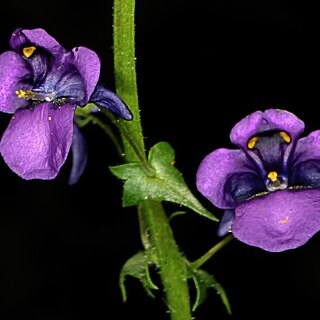Annual herb, main stem 10-750 mm long, 1-4 mm diam., occasionally simple, usually branching low down, weak, decumbent or ascending, glabrous, glandular-puberulous on the inflorescence axes. Leaves in 3-4 pairs on each branch, c. 10-50 x 10-45 mm, ovate, apex acute or subacute, base truncate to subcordate, margins subentire to sharply serrate, glabrous or with a few gland-tipped hairs on the lower margins and veins below; petioles sparsely glandular-pubescent, up to 20 mm long, decreasing rapidly in length, uppermost leaves subsessile. Flowers many, in long terminal racemes, simple or loosely panicled; lowermost bract leaf-like, upper ones becoming rapidly smaller, cordate-ovate, acuminate, sharply toothed, lower surface glandular-puberulous; pedicels c. 8-15 mm long, filiform, glabrous to sparsely glandular-puberulous, patent or deflexed, tip abruptly upcurved in fruit. Calyx lobes lanceolate, acute to shortly acuminate, anticous pair 2-3.5 x 0.5-1.25 mm, three posticous ones slightly smaller, glabrous or with a few glandular hairs at the base. Corolla tube c. 3 mm long, invaginated then partly turned out again; two lateral spurs c. 4 mm long, slightly curved, directed out then down, with dark sessile glands inside on one face; limb c. 10-13 x 9-11 mm, anticous lobe c. 4-5.5 x 5-8 mm, subrotund, lateral lobes c. 3-3.5 x 3-4.5 mm, subrotund, two posticous lobes 2-3 x 1.5-2 mm, fused nearly to the apex, corolla violet-blue, glabrous outside, inside with two patches of dark sessile glands laterally placed at the base of the anticous lobe, these glands also present below the upper sinuses; “window” concave, with two laterally placed elliptic yellow patches. Stamens projecting forward; filaments 2 mm long, glandular-puberulous, anthers 0.5 mm long, cohering strongly. Ovary 2 x 1 mm, deltoid in outline, ovules many in each loculus; style 1 mm long, stigma capitate, lying between the anthers. Capsules 9-16 x 1-2 mm, linear; seeds 1-1.25 x 0.3 mm, oblong, straight, flat or longitudinally folded, muricate.
More
Annual, up to 750 mm tall. Leaves ovate, serrate. Flowers in racemes, 2-spurred, deep violet with yellow windows, 8-13 mm long, spurs ± 3-4.5 mm long, projecting backwards and diverging, posterior stamens straight. Capsule linear, more-or-less straight or curved.
Annual to 75 cm. Leaves ovate, serrate. Flowers in racemes, 2-spurred, deep violet with yellow windows, 8-13 mm long, spurs ± 3.0-4.5 mm long, projecting backwards and diverging, posterior stamens straight. Capsules linear, ± straight or curved.

